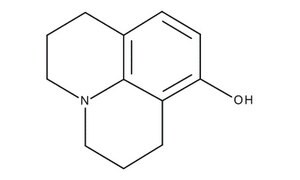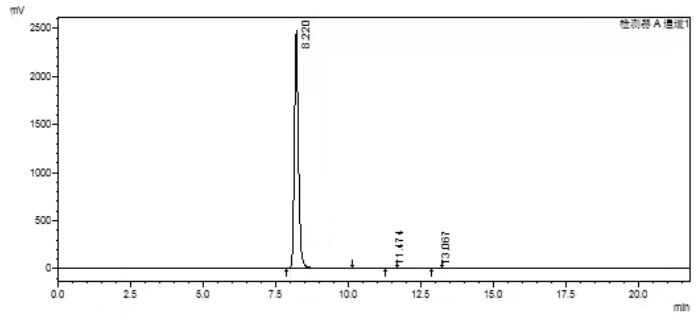8-HYDROXYJULOLIDINE CAS#: 41175-50-2; ChemWhat Code: 60806
Identification
| Product Name | 8-HYDROXYJULOLIDINE |
| IUPAC Name | 1-azatricyclo[7.3.1.05,13]trideca-5,7,9(13)-trien-6-ol |
| Molecular Structure |  |
| CAS Registry Number | 41175-50-2 |
| EINECS Number | 255-247-9 |
| MDL Number | MFCD00006918 |
| Beilstein Registry Number | No data available |
| Synonyms | 8-hydroxyjulolidine, 8-hydroxy-2,3,6,7-tetrahydro-1H,5H-benzo[ij]quinolizine, 2,3,6,7-tetrahydro-1H,5H-pyrido[3,2,1-ij]quinolin-8-ol, 1,2,3,5,6,7-hexahydropyrido[3,2,1-ij]quinolin-8-ol, 2,3,6,7-tetrahydro-1H,5H-benzo[ij]quinolizin-8-ol, 2,3,6,7-tetrahydro-1,5-benzo[H]quinolidine-8-ol, 4-diethyl-1,2,3,4-tetrahydroquinoxaline |
| Molecular Formula | C12H15NO |
| Molecular Weight | 189.25 |
| InChI | InChI=1S/C12H15NO/c14-11-6-5-9-3-1-7-13-8-2-4-10(11)12(9)13/h5-6,14H,1-4,7-8H2 |
| InChI Key | FOFUWJNBAQJABO-UHFFFAOYSA-N |
| Canonical SMILES | c1cc(c2c3c1CCCN3CCC2)O |
| Patent Information | ||
| Patent ID | Title | Publication Date |
| WO2017/59308 | METHODS FOR SYNTHESIZING RHODAMINE DYES | 2017 |
Physical Data
| Appearance | White powder |
| Solubility | Soluble in water (partly), ethanol, chloroform, methanol, and acetone. |
| Flash Point | No data available |
| Refractive index | No data available |
| Sensitivity | No data available |
| Melting Point, °C | Solvent (Melting Point) |
| 126 – 128 | |
| 126 – 130 | |
| 128.5 – 130.5 | ethanol |
| 134 – 136 | |
| 135 |
Spectra
| Description (NMR Spectroscopy) | Nucleus (NMR Spectroscopy) | Solvents (NMR Spectroscopy) | Frequency (NMR Spectroscopy), MHz | Original Text (NMR Spectroscopy) |
| Chemical shifts, Spectrum | 1H | chloroform-d1 | 300 | |
| Chemical shifts | 1H | dimethylsulfoxide-d6 | 400 | |
| Chemical shifts | 1H | dimethylsulfoxide-d6 | 400 | NMR (400 MHz, DMSO-d6): d 8.62 (s, 1H), 6.47 (d, 1H, J = 8.0 Hz), 5.99 (d, 1H, J = 8.0 Hz), 3.01-2.96 (m, 4H), 2.57-2.48 (m, 4H), 1.85-1.79 (m, 4H). |
| Chemical shifts | 13C | dimethylsulfoxide-d6 | 100 | 13C NMR (100 MHz, DMSO-d6): d 153.0, 143.6, 126.1, 111.9, 107.7, 103.0, 49.6, 49.1, 26.7, 22.1, 21.4, 21.0. |
| Chemical shifts, Spectrum | 1H | chloroform-d1 | 500 |
| Description (UV/VIS Spectroscopy) | Solvent (UV/VIS Spectroscopy) | Absorption Maxima (UV/VIS), nm |
| Spectrum | acetonitrile | 267, 303, 462 |
| Absorption maxima |
| Description (Mass Spectrometry) |
| high resolution mass spectrometry (HRMS), electrospray ionisation (ESI), spectrum |
| high resolution mass spectrometry (HRMS), electrospray ionisation (ESI), spectrum |
| high resolution mass spectrometry (HRMS), fast atom bombardment (FAB), spectrum |
Route of Synthesis (ROS)
| Conditions | Yield |
| With trichlorophosphate at 0 – 80℃; for 1.25h; Inert atmosphere; | 97.6% |
| Stage #1: N,N-dimethyl-formamide With trichlorophosphate at 4℃; for 0.25h; Stage #2: 8-hydroxyjulolidine at 20 – 100℃; for 1h; | 94% |
| Stage #1: N,N-dimethyl-formamide With trichlorophosphate at 4℃; for 0.25h; Stage #2: 8-hydroxyjulolidine In water at 4 – 100℃; for 2.5h; | 94% |
Safety and Hazards
| Pictogram(s) |  |
| Signal | Warning |
| GHS Hazard Statements | H315 (100%): Causes skin irritation [Warning Skin corrosion/irritation] H319 (100%): Causes serious eye irritation [Warning Serious eye damage/eye irritation] H335 (97.67%): May cause respiratory irritation [Warning Specific target organ toxicity, single exposure; Respiratory tract irritation] Information may vary between notifications depending on impurities, additives, and other factors. |
| Precautionary Statement Codes | P261, P264, P271, P280, P302+P352, P304+P340, P305+P351+P338, P312, P321, P332+P313, P337+P313, P362, P403+P233, P405, and P501 (The corresponding statement to each P-code can be found at the GHS Classification page.) |
Other Data
| Transportation | Not dangerous goods |
| Under the room temperature and away from light | |
| HS Code | No data availabe |
| Storage | Under the room temperature and away from light |
| Shelf Life | 2 years |
| Market Price | USD |
| Druglikeness | |
| Lipinski rules component | |
| Molecular Weight | 189.257 |
| logP | 2.353 |
| HBA | 1 |
| HBD | 1 |
| Matching Lipinski Rules | 4 |
| Veber rules component | |
| Polar Surface Area (PSA) | 23.47 |
| Rotatable Bond (RotB) | 0 |
| Matching Veber Rules | 2 |
| Use Pattern |
| 8-HYDROXYJULOLIDINE CAS#: 41175-50-2 used as OLED intermediates. |
| 8-HYDROXYJULOLIDINE CAS#: 41175-50-2 used as fluorescent materials. |
| 8-HYDROXYJULOLIDINE CAS#: 41175-50-2 used as fluorescent probes. |
| 8-HYDROXYJULOLIDINE CAS#: 41175-50-2 used as pharmaceutical intermediates. |
Buy Reagent | |
| No reagent supplier? | Send quick inquiry to ChemWhat |
| Want to be listed here as a reagent supplier? (Paid service) | Click here to contact ChemWhat |
Approved Manufacturers | |
| Warshel Chemical Ltd | http://www.warshel.com/ |
| Want to be listed as an approved manufacturer (Requires approvement)? | Please download and fill out this form and send back to approved-manufacturers@chemwhat.com |
Contact Us for Other Help | |
| Contact us for other information or services | Click here to contact ChemWhat |


